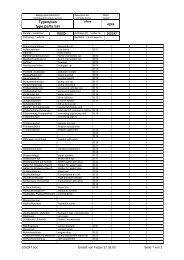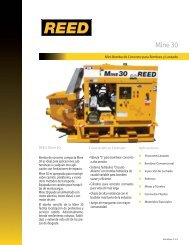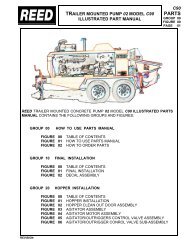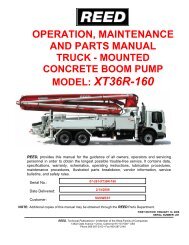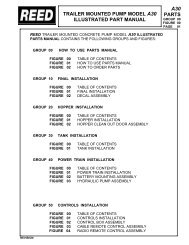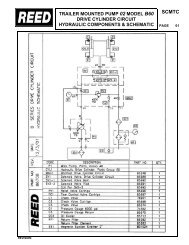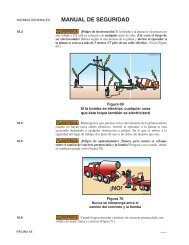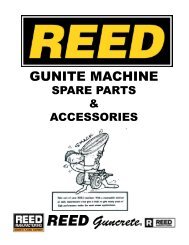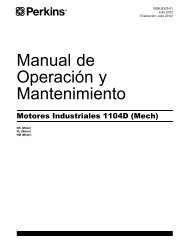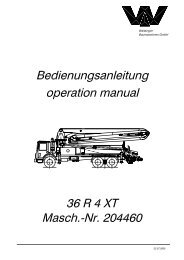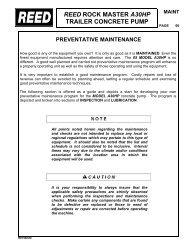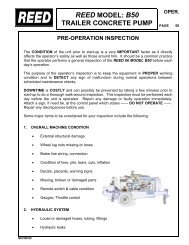Perkins Motor Operation and Maintenance Manual (English) - REED
Perkins Motor Operation and Maintenance Manual (English) - REED
Perkins Motor Operation and Maintenance Manual (English) - REED
You also want an ePaper? Increase the reach of your titles
YUMPU automatically turns print PDFs into web optimized ePapers that Google loves.
SEBU8325-01 7<br />
Safety Section<br />
General Hazard Information<br />
When pressurized air <strong>and</strong>/or water is used for<br />
cleaning, wear protective clothing, protective shoes,<br />
<strong>and</strong> eye protection. Eye protection includes goggles<br />
or a protective faceshield.<br />
The maximum air pressure for cleaning purposes<br />
must be below 205 kPa (30 psi). The maximum<br />
water pressure for cleaning purposes must be below<br />
275 kPa (40 psi).<br />
Fluid Penetration<br />
Illustration 5<br />
Wear a hard hat, protective glasses, <strong>and</strong> other<br />
protective equipment, as required.<br />
g00702020<br />
Do not wear loose clothing or jewelry that can snag<br />
on controls or on other parts of the engine.<br />
Make sure that all protective guards <strong>and</strong> all covers<br />
are secured in place on the engine.<br />
Pressure can be trapped in the hydraulic circuit long<br />
after the engine has been stopped. The pressure can<br />
cause hydraulic fluid or items such as pipe plugs to<br />
escape rapidly if the pressure is not relieved correctly.<br />
Do not remove any hydraulic components or parts<br />
until pressure has been relieved or personal injury<br />
may occur. Do not disassemble any hydraulic<br />
components or parts until pressure has been relieved<br />
or personal injury may occur. Refer to the OEM<br />
information for any procedures that are required to<br />
relieve the hydraulic pressure.<br />
Keep the engine free from foreign material. Remove<br />
debris, oil, tools, <strong>and</strong> other items from the deck, from<br />
walkways, <strong>and</strong> from steps.<br />
Never put maintenance fluids into glass containers.<br />
Drain all liquids into a suitable container.<br />
Obey all local regulations for the disposal of liquids.<br />
Use all cleaning solutions with care.<br />
Report all necessary repairs.<br />
Do not allow unauthorized personnel on the<br />
equipment.<br />
Illustration 6<br />
g00687600<br />
Ensure that the power supply is disconnected before<br />
you work on the bus bar or the glow plugs.<br />
Perform maintenance on the engine with the<br />
equipment in the servicing position. Refer to the<br />
OEM information for the procedure for placing the<br />
equipment in the servicing position.<br />
Pressure Air <strong>and</strong> Water<br />
Pressurized air <strong>and</strong>/or water can cause debris<br />
<strong>and</strong>/or hot water to be blown out. This could result in<br />
personal injury.<br />
The direct application of pressurized air or<br />
pressurized water to the body could result in personal<br />
injury.<br />
Always use a board or cardboard when you check<br />
for a leak. Leaking fluid that is under pressure can<br />
penetrate body tissue. Fluid penetration can cause<br />
serious injury <strong>and</strong> possible death. A pin hole leak can<br />
cause severe injury. If fluid is injected into your skin,<br />
you must get treatment immediately. Seek treatment<br />
from a doctor that is familiar with this type of injury.<br />
Containing Fluid Spillage<br />
Care must be taken in order to ensure that fluids<br />
are contained during performance of inspection,<br />
maintenance, testing, adjusting <strong>and</strong> repair of the<br />
engine. Make provision to collect the fluid with a<br />
suitable container before any compartment is opened<br />
or before any component is disassembled.<br />
• Only use the tools that are suitable for collecting<br />
fluids <strong>and</strong> equipment that is suitable for collecting<br />
fluids.



